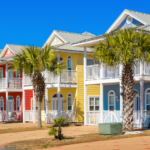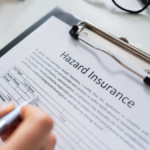Hurricane season has historically run from June 1st to November 30th in the Atlantic Ocean, during which tropical storms and hurricanes can hit the United States, Puerto Rico, and other parts of the Caribbean. But you can’t put parameters like dates on Mother Nature, and unfortunately, hurricanes are starting earlier and ending later in the season than expected.
In recent years, several devastating hurricanes have wiped out entire neighborhoods and caused severe damage to homes and infrastructure in some areas that have never experienced hurricane activity before. These changes, and the apparent randomness, highlight the importance of homeowners having adequate insurance coverage.
But does home insurance cover hurricane damage?
The short answer is that it depends on the type of home insurance policy you have and the specific coverage options you select. Most standard home insurance policies include coverage for damage caused by windstorms, which can include wind damage associated with hurricanes. However, some policies may have exclusions or limitations on windstorm coverage, especially for homes in coastal regions, islands, and other hurricane-high-risk areas.
In addition to wind damage, hurricanes can cause home destruction in other ways, like catastrophic flooding, which is not typically covered by standard home insurance policies. Because of this, homeowners may need to purchase additional flood insurance coverage to protect their homes from storm surges and rising waters caused by hurricanes.
Increased severity on the East Coast
Climate change, unfortunately, is having a major impact on hurricanes in the United States. Although scientists are uncertain about whether this means we’ll see more hurricanes in a season, it’s clear that their intensity and severity will continue to increase — they’re more powerful and lingering longer!
As a result, hurricanes are increasingly more destructive and are leaving behind massive financial burdens. To address this issue, communities both on the coast and inland need to strengthen their resilience — and homeowners in hurricane-rattled areas need to get the proper insurance.
In 2022, three hurricanes made landfall along the US East Coast. The most damaging was Hurricane Ian, which devastated parts of Florida. Newsweek estimates that over a million households in the state’s hardest-hit areas are without flood insurance and have had to pay out of pocket to cover the costs of repairing or rebuilding their homes. Losses are said to have been as high as $100 billion.
Of the most severe hurricanes in recent history is Hurricane Katrina, which hit the Gulf Coast in 2005 and tore New Orleans apart, causing an estimated $125 billion in damages. In 2012, Hurricane Sandy did the same to New York and New Jersey, causing widespread flooding, power outages, and an estimated $70 billion in damages.
Then there was Hurricane Maria, which hit Puerto Rico in 2017 and was one of the most devastating hurricanes in the island’s history. The island was left without power for several months, and homeowners still face significant challenges in the aftermath, including difficulty getting insurance coverage and repairing their homes.
The West Coast is affected, too!
While hurricanes are more commonly associated with southern states and the Caribbean, they can still impact other regions. The western United States is not typically in the direct path of hurricanes, but when they happen, expect heavy rain and flooding.
For example, Hurricane Nora devastated parts of northern Mexico in 1997 before slipping into the U.S., leaving thousands without power and flooding homes in California and Arizona. It caused several hundred million dollars in damages, with $40 million in damages suffered by regional lemon farmers. Winds took down trees and damaged houses as far inland as Utah. There’s even a town in Utah called Hurricane!
In the eastern Pacific Ocean, these storms are often called typhoons. In rare cases, they can reach Hawaii and cause significant problems. In 1992, Hurricane Iniki struck the island of Kauai, killed seven, injured well over one hundred residents, and generated over $1.8 billion in damage.
Is it hard to get hurricane insurance?
Insurance companies have had a complex history with hurricane coverage. In the past, many insurance companies offered coverage for hurricane damage as part of their standard policies, but as the frequency and severity of hurricanes increased, some companies stopped offering this coverage, especially in areas of high risk. This has left many homeowners vulnerable and struggling to find affordable coverage.
In response to these challenges, some states have created government-backed insurance programs to help homeowners obtain coverage for hurricane damage. For example, after Florida was devastated by 1992’s Hurricane Andrew, the Florida Hurricane Catastrophe Fund was created to provide coverage for high-risk properties that cannot obtain coverage elsewhere.
What about windstorm coverage?
In some cases, homeowners might want to look into specialized windstorm insurance to be on the safe side. Windstorm coverage protects from damage caused by strong winds, often including wind associated with hurricanes, tornadoes, and other harsh weather events. Standard homeowner policies often include this protection as part of their primary coverage, but the depth of coverage can vary depending on the policy and your home’s location.
There are also degrees in how much these insurance policies cover damage to other structures on the property, like garages and sheds, and things like outdoor furniture, landscaping, or detached structures not used for storage — like a guest room or home office. Some policies may also have optional coverage for debris removal, temporary living expenses, and reimbursement for lost rental income if your property is leased out.
In addition to windstorm coverage, homeowners in areas prone to hurricanes or other severe weather events may also need to consider purchasing additional insurance coverage for flooding and water damage. Flooding is typically not covered under standard homeowners insurance policies and requires separate flood insurance coverage.
Hurricanes are scary. Getting coverage shouldn’t be.
As hurricanes become more frequent and severe, it’s more important than ever to be adequately prepared and protected.
By reviewing your policy and discussing your options with your insurance provider, you can ensure that you have the necessary coverage to protect your home and belongings in the event of windstorm damage.
We can help you find the best home insurance options by comparing policies from both major and local carriers. Our service is free and provides you with same-day results. To get started, all we need is some basic information from you.










